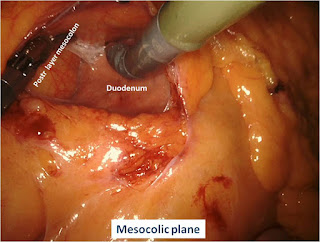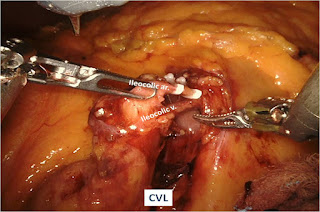Part A. Techniques of Colorectal Anastomoses
We attended the recently held annual conference of the Society of American Gastrointestinal & Endoscopic Surgeons (SAGES) in the lovely city of Baltimore, USA April 2019. This was a well organised scientific meeting that fully lived up to the high standards expected of all SAGES meetings. Our team also presented 3 papers including one on outcomes of colorectal surgery in our department (Outcomes following colorectal surgery: A comparative study CR-POSSUM and ACS-NSQIP risk calculator. Abstract published in Surg Endosc. 2019;33:S241)
One of the key areas of focus for SAGES has been minimally invasive colorectal surgery (MI-CRS). Through interactive sessions and hands on courses, acknowledged leaders in the field discussed current best practices on wide range of subjects including techniques of safe anastomosis and early identification and appropriate management of anastomotic leaks.
Through a series of blogs, we will present salient features and provide a brief literature review pertaining to safe colorectal anastomosis:
- Techniques of colorectal anastomosis
- Intraoperative assessment of anastomotic integrity
- Management of anastomotic leak
First blog of the series covers part A and remaining parts B & C shall be covered in subsequent blogs. - Techniques of colorectal anastomosis
- Ileocolic anastomosis following MI right colectomy: Extracorporeal or Intracorporeal?
In view of its technical simplicity, extracorporeal anastomosis (ECA) is currently the preferred method for reconstruction following MI right colectomy. For ECA, the specimen is delivered through the midline extraction site and anastomosis is performed outside the abdomen.1 When ECA is planned, bowel resection should preferably be done extracorporeal as this obviates of risk of anastomosis between twisted bowel ends – particularly ileum.
Following resection, depending on surgeon’s preference, a side to side, isoperistaltic ileocolic ECA can then be completed in classical hand sewn or stapled manner.
An Intracorporeal anastomosis (ICA) is performed within the peritoneal cavity after the specimen is completely detached from surrounding structures. The specimen is ‘bagged’ and subsequently removed thorough Pfannenstiel incision.
ICA is a stapled, side to side ileocolic anastomosis. Special focus is needed towards a safe laparoscopic closure of enterotomy (for stapler access) in view of its propensity to leak. When doing a sutured closure, the standard two layer technique using running barbed suture in the first layer is reported to be associated with lesser incidence of leak and bleeding.2 The same study also reported totally stapled closure and robotic assisted are reported as non-inferior alternatives.2
A further valuable tip was provided by the expert panel during deliberations at the SAGES meeting – while doing a laparoscopic enterotomy closure with running barbed wire suture (V – Lock), absorbable clip should be applied after first stitch to keep this stitch snug.
ICA has several advantages including short term morbidity and shorter hospital stay3:
– Particularly suitable for obese patients and those with shortened mesentery
– No risk of ‘twisted’ anastomosis
– Less postoperative pain
– Better cosmetic outcomes
– Less prone to incisional hernia
– Lower complication rate
– Earlier discharge from the hospital The disadvantages of ICA include:
– Needs high laparoscopic suturing skills
– Needs more time
Ileocolic anastomosis following MI right colectomy : Hand sewn or stapled
Recent European studies (population based Swedish study, nationwide retrospective Danish cohort study and a prospective multicenter study) have reported that the anastomotic leak rate following ileocolic anastomosis in patients with right colon cancer ranges between 3.2-8.4%4,5. Further these studies report an increase (Odds ratio 2.04 -2.91) risk anastomotic leak following stapled anastomosis as compared to hand sewn anastomosis4,5,6. Besides lower leak rate, the latter has advantage of lower material costs also6.
- Left sided ICA without using staplers
Invited experts through operative videos demonstrated robot assisted sigmoid colectomy for diverticular disease. The resected colon was delivered through the anal orifice thus obviating any incision to extract the specimen. The colorectal anastomosis was then fashioned with interrupted sutures in single layer similar to open surgery without using stapler.
Our technique:
We currently perform minimally invasive right colectomy with modified complete mesocolic excision (mCME ; Figure 1) with central vascular ligation (CVL; Figure 2) for patients of right colon cancer. All patients have had extracorporeal side to side, isoperistaltic, double layered, hand sewn ileo-colic anastomosis. We initiated minimally invasive right colectomy 5 years ago and with this technique we have had no anastomotic leaks and all patients had uneventful recovery.

Figure 1: Robotic right hemicolectomy for cancer colon – mCME

Figure 2: Robotic right hemicolectomy for cancer colon – CVL
References
- Cleary R K, Kassir A, Johnson C S et al. Intracorporeal versus extracorporeal anastomosis for minimally invasive right colectomy: A multicenter propensity score matched comparative study.
Plos One doi.org/10.1371/journal.pone.0206277
- Milone M, Elmore U, Allaix ME et al. Fashioning enterotomy closure after totally laparoscopic ileocolic anastomosis for right colon cancer: a multicenter experience
Surg Endosc 2019 doi 10.1007/s00464-019-06796-w
- Van Oostendorp S, Elfrink A, Borstlap W et al. Intracorporeal versus extracorporeal anastomosis in right hemicolectomy: a systematic review and meta analysis
Surg Endosc 2017;31(1): 64-77
- Nordholm – Carstensen A, Schnack Rasmussen M, Krarup PM. Increased leak rate following stapled versus handsewn ileocolic anastomosis in patients with right colon cancer: A nationwide cohort study
Dis Colon Rectum 2019;62:542-548
- Frasson M, Granero – Castro P, Ramos RJL et al. Risk factors for anastomotic leak and postoperative morbidity and mortality after elective right colectomy for cancer: results from a prospective multicentric study of 1102 patients.
Int J Colorectal Dis 2016;31:105-14
- Gustaffson P, Jestin P, Gunnarson U et al. Higher frequency of anastomotic leakage with stapled compared to hand sewn ileocolic anastomosis in a large population based study. World J Surg;39:1834-9
Authors:
Dr Nitin Vashistha, MS, FIAGES, FACS
Dr Dinesh Singhal, MS, FACS, DNB (Surg Gastro)
Department of Surgical Gastroenterology,
Max Super Speciality Hospital, Saket, New Delhi, India
E mail: gi.cancer.india@gmail.com

